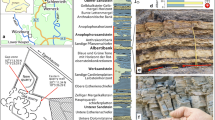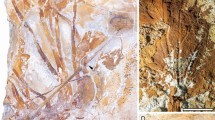Abstract
The Middle Jurassic (Aalenian-Bajocian) shallow marine deposits of Bearreraig Bay, Skye, northwest Scotland, have yielded calcite-permineralized leaves of cycadophytes showing unusually well preserved anatomy. Morphological characters identify the leaves asNilssonia cf.tenuinervis Seward (Cycadales),Otozamites mortonii sp. nov. (Bennettitales), a putative juvenile leaf showing imbricate, recurved pinnae, andOtozamites sp. Permineralized Jurassic cycadophytes occur in only four other localities worldwide; the better-known coeval adpression flora of Yorkshire lacks anatomical preservation. Past studies of fossil cycadophyte species have therefore emphasized morphology, whereas the Skye specimens reveal details of anatomy greatly exceeding published descriptions of similar species. The arrangement of vascular tissues in the rachis ofOtozamites resembles that described forPtilophyllum cutchense Morris (Bennettitales) from India. Stomata observed in the preserved cuticle of theNilssonia leaf superficially resemble those of the extant cycadMacrozamia Miquel. Given the 180 million years separating these two genera, and the fragmentary preservation and equivocal phylogenetic position ofNilssonia, comparative interpretations remain tentative. Leaf characters have been little used in phylogenetic analyses, reflecting exaggerated fears of anatomical and morphological convergence; these characters therefore require particular attention when comparing fossil cycadophytes with their living relatives.
Similar content being viewed by others
Literature Cited
Archangelsks A., R. Andreis, S. Archangelsky &A. Artabe. 1995. Cuticular characters adapted to volcanic stress in a new Cretaceous cycad leaf from Patagonia, Argentina. Rev. Paleobot. Palynol. 89: 213–233.
Barale, G. 1981. La paléoflore Jurassique du Jura Français. Documents de Laboratoire de Géologie Lyon, 81.
Barbacka, M. &J. H. A. van Konijnenburg-van Cittert. 1998. Sun and shade leaves in two Jurassic species of pteridosperms. Rev. Paleobot. Palynol. 103: 209–221.
Bateman, R. M. 1999. Bulk geochemistry as a guide to provenance and diagenesis. Pp. 169–173in T. P. Jones & N. P. Rowe (eds.), Fossil plants and spores: Modern techniques. Geological Society, London.
— &N. Morton. 1994. New petrified Middle Jurassic floras from nearshore marine sediments at Bearreraig, Skye. Amer. J. Bot. 81: 88 (abstract).
— &N. J. Simpson. 1998. Comparing phylogenetic signals from reproductive and vegetative organs. Pp. 231–253in S. J. Owens & P. J. Rudall (eds.), Reproductive biology in systematics, conservation and economic botany. Royal Botanic Gardens, Kew.
—,N. Morton &B. L. Dower. 2000. Early Middle Jurassic communities in northwest Scotland: Paleoecological and paleoclimatic significance. Pp. 501–511in R. Hall, P. Smith & T. Poulton (eds.), GeoResearch Forum 6 (Proceedings of the Fifth International Symposium on the Jurassic System). TransTech Publications, Zurich.
Bold, H. C., C. J. Alexopoulos &T. Delevoryas. 1987. Morphology of plants and fungi. Harper & Row, New York.
Bose, M. N. 1953.Ptilophyllum amarjolense, sp. nov. from the Rajmahal Hills, Bihar. Proc. Nat. Inst. Sci., India 19: 605–612.
— &M. L. Kasat. 1972a. The genusPtilophyllum in India. Palaeobotanist 19: 115–143.
——. 1972b. On a petrified specimen ofDictyozamites from the Rajmahal Hills, India. Palaeobotanist 19: 248–252.
Chaw, S.-M., C. L. Parkinson, Y. Cheng, T. M. Vincent &J. D. Palmer. 2000. Seed-plant phylogeny inferred from all three plant genomes: Monophyly of extant gymnosperms and origins of Gnetales from conifers. Proc. Natl. Acad. Sci. USA 97: 4086–4091.
Crane, P. R. 1985a. Phylogenetic analysis of seed plants and the origin of angiosperms. Ann. Missouri Bot. Gard. 72: 716–793.
— 1985b. Morphology and relationships of the Bennettitales. Pp. 162–175in R. A. Spicer & B. A. Thomas (eds.), Systematic and taxonomic approaches in palaeobotany. Systematics Association Special Publication 31. Oxford University Press, New York
— 1988. Major clades and relationships in “higher” gymnosperms. Pp. 218–272in C. B. Beck (ed.), Origin and evolution of gymnosperms. Columbia Univ. Press, New York.
Delevoryas, T. 1962. Morphology and evolution of fossil plants. Holt, Rinehart, and Winston, New York.
— 1968. Some aspects of cycadeoid evolution. Bot. J. Linn. Soc. 61: 137–146.
— 1982. Perspectives on the origin of cycads and cycadeoids. Rev. Paleobot. Palynol. 37: 115–132.
Donoghue, M. J., J. A. Doyle, J. Gauthier, A. G Kluge &T. M. Rowe. 1989. The importance of fossils in phylogeny reconstruction. Ann. Rev. Ecol. Syst. 20: 431–460.
Doyle, J. A. &M. J. Donoghue. 1986. Seed plant phylogeny and the origin of angiosperms: An experimental cladistic approach. Bot. Rev. 52: 321–431.
—— 1987. The importance of fossils in elucidating seed plant phylogeny and macroevolution. Rev. Paleobot. Palynol. 50: 63–95.
—— 1992. Fossils and seed plant phylogeny reanalyzed. Brittonia 44: 89–106.
Esau, K. 1953. Plant anatomy. Wiley, New York.
Fahn, A. 1967. Plant anatomy. Pergamon Press, New York.
Florin, R. 1933. Studien über Cycadales des Mesozoicums nebst Erorterungen über die Spaltöffnungsapparate der Bennettitales. K. svenska. Vetensk Akad. Handl., Tredje Ser. 12: 1–134.
Gifford, E. M. &A. S. Foster. 1989. Morphology and evolution of vascular plants. Ed 3. W. H. Freeman, New York.
Gillespie, W. H. &H. W. Pfefferkorn. 1986. Taeniopterid lamina onPhasmatocycas megasporophylls (Cycadales) from the Lower Permian of Kansas, U.S.A. Rev. Paleobot. Palynol. 49: 99–116.
Greguss, P. 1965. The relationships of Cycadales on the basis of their xylotomy, branching and leaf epidermis. Palaeobotanist 14: 94–101.
Harris, T. M. 1937. The fossil flora of Scoresby Sound, East Greenland. Medd, Grønland, Khøbenhavn, 112: 1–114, pl. 1.
— 1961. The fossil cycads. Palaeontology 4: 313–323.
— 1964. The Yorkshire Jurassic flora, II. Caytoniales, Cycadales and Pteridospermales. British Museum (Natural History), London.
— 1969. The Yorkshire Jurassic Flora, III. Bennettitales. British Museum (Natural History), London.
Jones, D. L. 1993. Cycads of the world. Smithsonian Institution Press, Washington, DC.
Jones, T. &N. P. Rowe (eds.). 1999. Fossil plants and spores: Modern techniques. Geological Society, London.
Joy, K. W., A. J. Willis &W. S. Lacey 1956. A rapid cellulose peel technique in palaeobotany. Ann. Bot. 20: 635–637.
Kimura, T. &M. Tsujii. 1982. Early Jurassic plants of Japan. Part 4. Trans. Proc. Palaeont. Soc. Japan, N.S. 125: 259–276.
Krassilov, V. A. 1976. Bennettitalean stomata. Palaeobotanist 25: 179–184.
Kvacek, J. 1995. Cycadales and Bennettitales leaf compressions of the Bohemian Cenomanian, Central Europe. Rev. Paleobot. Palynol. 84: 389–412.
Loconte, H. &D. W. Stevenson. 1990. Cladistics of the Spermatophyta. Brittonia 42: 197–211.
Magallon, S. &M. J. Sanderson. 2002. Relationships among seed plants inferred from highly conserved genes: Sorting conflicting phylogenetic signals among ancient lineages. Amer. J. Bot. 89: 1991–2006.
Meeuse, A. D. J. 1961. The Pentoxylales and the origin of the monocotyledons. Proc. Koninklijke Neederl. Akad. Wentsensch. 82: 343–369.
Morton, N. 1984. Aalenian-Bajocian boundary at Bearreraig, Isle of Skye, Scotland. Pp. 341–352in J. Michelsen and A. Zeiss (eds.), International Symposium on Jurassic Stratigraphy. Geological Survey of Denmark, Copenhagen.
Nixon, K. C., W. L. Crepet, D. Stevenson &E. M. Friis. 1994. A reevaluation of seed plant phylogeny. Ann. Missouri Bot. Gard. 81: 484–533.
Norstog, K. &T. Nicholls. 1997. The biology of the cycads. Cornell Univ. Press, Ithaca, NY.
Oldham, T. C. B. 1976. Flora from the Wealden plant-debris beds of England. Palaeontology 19: 1–437.
Pant, D. D. 1987. The fossil history and phylogeny of the Cycadales. Geophytology, 17: 125–162.
— 1990. On the genusGlandulataenia from the Triassic of Nidpuri, India. Mem. New York Bot. Gard. 57: 186–199.
— &D. D. Nautiyal. 1963. Cuticle and epidermis of recent Cycadales: Leaves sporangia and seeds. Senck. Biol. 44: 257–348.
Person, C. P. &T. Delevoryas. 1982. The Middle Jurassic flora of Oaxaca, Mexico. Palaeontographica Abt. B 180: 82–119.
Phillips, T. L. &W. A. DiMichele. 1992. Comparative ecology and life-history biology of arborescent lycopsids in Late Carboniferous swamps of Euramerica. Ann. Missouri Bot. Gard. 79: 560–588.
Poole, J. P. 1923. Comparative anatomy of leaves of cycads, with reference to the cycadofilicales. Bot. Gaz. 76: 203–214.
Rao, A. R. &V. Achuthan 1967. Further contribution to our knowledge ofPtilophyllum. Palaeobotanist 16: 249–257.
Rothwell, G W. &R. Serbet. 1994. Lignophyte phylogeny and the evolution of spermatophytes: A numerical cladistic analysis. Syst. Bot. 19: 443–482.
Seward, A. C. 1911. The Jurassic flora of Sutherland. Trans. R. Soc. Edinburgh 47: 643–709.
Sharma, B. D. 1967. Investigations on the Jurassic flora of Rajmahal Hills, India. Palaeontographica Abt. B. 120: 139–150.
Soltis, D. E., P. S. Soltis &M. J. Zanis. 2002. Phylogeny of seed plants based on evidence from eight genes. Amer. J. Bot. 89: 1670–1681.
Stevenson, D. W. 1981. Observations on ptyxis, phenology, and trichomes in the Cycadales and their systematic implications. Amer. J. Bot. 68: 1104–1114.
— 1990. Morpholgy and systematics of the Cycadales. Mem. New York Bot. Gard. 57: 8–55.
—K. J. Norstog &D. V. Molsen. 1996. Midribs of cycad pinnae. Brittonia 48: 67–74.
Stewart, W. N. &G W. Rothwell. 1993. Paleobotany and the evolution of plants. Cambridge Univ. Press, Cambridge.
Stopes, M. C. 1910. The internal anatomyof “Nilssonia orientalist” Ann. Bot. 14: 389–393.
Suhk-Dev &Zeba-Bano. 1975. Three species ofPtilophyllum from Basna, Madhya Pradesh. Palaeobotanist 24: 161–189.
Taylor, T. N. &E. L. Taylor. 1993. The biology and evolution of fossil plants. Prentice Hall, Englewood Cliffs, NJ.
Theissen, G., A. Becker, K.-U. Winter, T. Münster, C. Kirchner &H. Saedler. 2002. How the land plants learned their floral ABCs: The role of MADS-box genes in the evolutionary origin of flowers. Pp. 173–205in Q. C. B. Cronk, R. M. Bateman & J. A. Hawkins (eds.), Developmental genetics and plant evolution. Taylor & Francis, London.
Thomas B. A. &R. A. Spicer. 1987. The evolution and palaeobiology of land plants. Croom Helm, London and Sydney.
Thomas, H. H. 1925. The Caytoniales: A new group of angiospermous plants from the Jurassic rocks of Yorkshire. Phil. Trans. R. Soc. Lond. B 213: 299–363.
Tidwell, W. D., J.-H. Kim &T. Kimura. 1987. Mid-Mesozoic leaves from near Ida Bay, southern Tasmania, Australia. Pap. Proc. R. Soc. Tasmania 121: 159–170.
Van Konijnenburg-van Cittert, J. H. A. &J. van der Burgh. 1989. The flora from the Kimmeridgian (Upper Jurassic) of Culgower, Sutherland, Scotland. Rev. Paleobot. Palynol. 61: 1–51.
Watson, J. &C. A. Sincock. 1992. Bennettitales of the English Wealden. Monograph of the Palaeontological Society, London.
Author information
Authors and Affiliations
Rights and permissions
About this article
Cite this article
Dower, B.L., Bateman, R.M. & Stevenson, D.W. Systematics, ontogeny, and phylogenetic implications of exceptional anatomically preserved cycadophyte leaves from the Middle Jurassic of Bearreraig Bay, Skye, northwest Scotland. Bot. Rev 70, 105–120 (2004). https://doi.org/10.1663/0006-8101(2004)070[0105:SOAPIO]2.0.CO;2
Issue Date:
DOI: https://doi.org/10.1663/0006-8101(2004)070[0105:SOAPIO]2.0.CO;2




